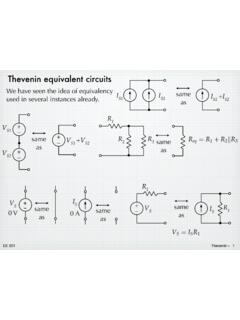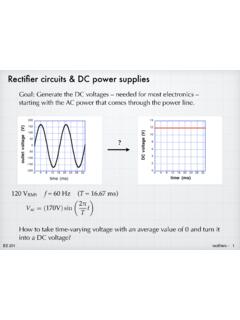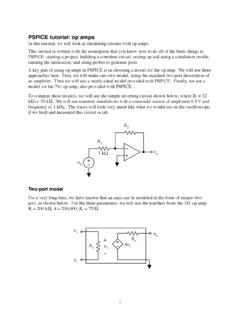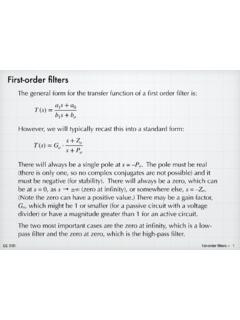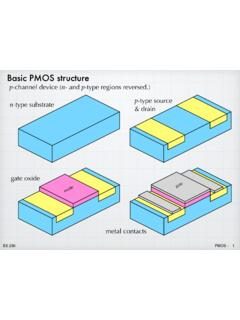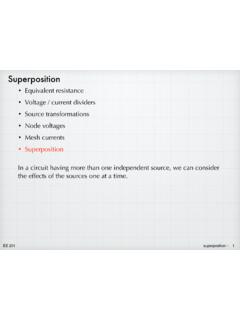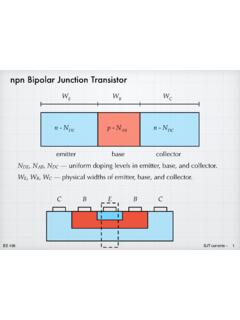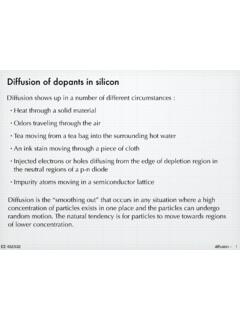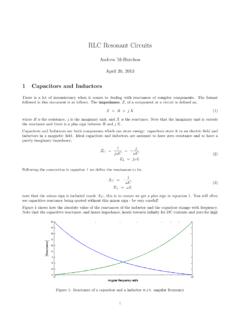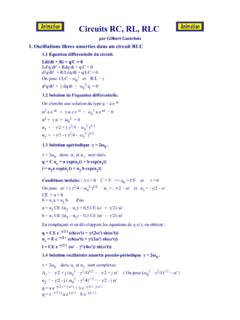Transcription of Solving circuits directly using Laplace
1 EE 230 Laplace circuits 1 Solving circuits directly using LaplaceThe Laplace method seems to be useful for Solving the differential equations that arise with circuits that have capacitors and inductors and sources that vary with time (steps and sinusoids.) The approach has been to: the circuit in the time domain using familiar circuit analysis techniques to arrive at a differential equation for the time-domain quantity of interest (voltage or current). a Laplace transform on the differential equation to arrive a frequency-domain form of the quantity of interest. the frequency-domain algebra expression. back to the time-domain.
2 Might it possible to change the order of the steps? Could we transform the circuit into the frequency domain and then use circuit techniques to find the desired voltage or current? Might this is approach be easier than Solving differential equations? Not surprisingly, the answer to all three questions is Yes! EE 230 Laplace circuits 2 Frequency domain impedancesIn order to transform a circuit directly , we need frequency-domain descriptions of the all of the components in the circuit . We already know how to transform the commonly used step and sinusoidal sources. We need to consider resistors, inductors, and capacitors to see the form of the current-voltage relationships in the frequency domain.
3 Apply the Laplace transform to the i-v equations directly . +vR(t)iR(t)VRIR=R +VR(s)IR(s) +vC(t)iC(t)iC(t)=CdvC(t)dtIC(s)=C s VC(s)VCIC=1sC +VC(t)IC(s) +vL(t)iL(t)vL(t)=LdiL(t)dtVL(s)=L s IL(s)VLIL=sL +VL(s)IL(s)VR(s)=R IR(s)vR(t)=R iR(t)EE 230 Laplace circuits 3 For the resistor, the frequency domain relationship is exactly the same as the the time domain. (Ohm s Law is not time-dependent, so this is not a surprise.) For the inductor and capacitor, the frequency domain relations are actually simpler. All three components can be treated with a simple Ohm s-Law-like current-voltage equation:V(s)=Z I(s)where Z is known as the impedance , with units of ohms ( ).
4 ZR=RZC=1sCZL=sLZC and ZL depend on frequency, but for a given frequency, they are constants. They are complex constants (since s is complex), but the frequency domain relationships are exactly like those of the resistor: voltage is equal to a constant multiplied by the current. This means that the circuit in the frequency domain can be solved using all of the methods that we learned for circuits with sources and resistors at the very beginning of EE 230 Laplace circuits 4Of course this frequency-domain approach is very similar to the complex analysis used for AC circuits in EE 201. In fact, AC analysis as introduced 201 is simply a special case of the Laplace approach.
5 In our Laplace expressions, if we restrict the complex frequency to just imaginary values, s = j , the two approaches become of the familiar techniques learned in 201 apply in the frequency domain, as well: equivalent resistances (now equivalent impedances) voltage / current dividers * source transformations node voltages * mesh currents superpositionEE 230 Laplace circuits 5 Now, with the approach of transforming the circuit into the frequency domain using impedances, the Laplace procedure becomes: the circuit . Use the Laplace transform version of the sources and the other components become impedances. the circuit using any (or all) of the standard circuit analysis techniques to arrive at the desired voltage or current, expressed in terms of the frequency-domain sources and impedances.
6 Back to the time-domain. (If needed.)The following examples illustrate the 230 Laplace circuits 6 Example 1 Find the Laplace (frequency domain) expression for vC in the RC circuit below. The input is a step function, vi (t) = Vf u(t)The frequency domain circuit is easily solved using a voltage +RVi(s)VC(s)=ZCZC+ZRVi(s)ZR=RVi(s)=Vfs=V f/RCs(s+1RC)Convert the circuit to the frequency (s)=1 RCs+1RC(Vfs)RC +vC (t)vi (t)+ 0 Vft = 0 ++ ZRZCVC (s)Vi (s)EE 230 Laplace circuits 7 Example 2 The same RC circuit , but now with a sinusoidal source, vi = VA cos( t).vi(t)=VA cos( t)ZC=1sCZR=RConvert the circuit to the frequency domain.
7 It looks (s)=VA ss2+ 2 The R and C impedances still form a voltage +RVi(s)VC(s)=ZCZC+ZRVi(s)=VARC s(s+1RC)(s2+ 2)VC(s)=1 RCs+1RC(VA ss2+ 2)RC +vC (t)vi (t)+ ++ ZRZCVC (s)Vi (s)EE 230 Laplace circuits 8 Example 3 Find the Laplace (frequency domain) expression for vC in the RLC circuit below. The input is a step function, vi (t) = Vf u(t).RC +vC (t)+ Lvi (t)ViVft = 0ZC=1sCVi(s)=VfsZL=sLThis can still be handled as a voltage +1sC+sLVi(s)VC(s)=ZCZR+ZC+ZLVi(s)VC(s)=( 11+sRC+s2LC)(Vfs)=VfLCs(s2+sRL+1LC) ++ ZRZCVC (s)Vi (s)ZLConvert to the frequency domain. ZR=REE 230 Laplace circuits 9 The same RLC circuit as Example 3, but now with a sinusoidal source, vi = VA cos( t).
8 Example 4vi(t)=VA cos( t)ZC=1sCZL=sLVi(s)=VA ss2+ 2 Yep, it s still a voltage +1sC+sLVi(s)VC(s)=ZCZR+ZC+ZLVi(s)VC(s)=( 11+sRC+s2LC)(VAs2+ 2)=VALC(s2+ 2)(s2+sRL+1LC)RC +vC (t)+ Lvi (t) ++ ZRZCVC (s)Vi (s)ZLZR= 230 Laplace circuits 10 Let s try an op-amp with a step-voltage input. Find the frequency-domain expression for the output, Vo(s).Example 5 +CR2R1vo (t)vi (t)0 Vft = 0Vi(s)=VfsZR1=R1ZR2=R2ZC=1sCConvert to the frequency domain. +ZR1ZR2 ZCVi (s)Vo (s)First, combine ZR2 and ZC to make the parallel (1sC)=R21+sR2 CIt is just a simple inverting amp! +ZR1ZR2 CVi (s)Vo (s)Vo(s)=( ZR2 CZR1)Vi(s)=( R2R11+sR2C)(Vfs)= VfR1Cs(s+1R2C)EE 230 Laplace circuits 11 Example 6 Same op amp circuit , but now with a sinusoidal input.
9 +CR2R1vo (t)vi (t)vi(t)=VA cos( t) +ZR1ZR2 CVi (s)Vo (s)Convert to the frequency domain. Combine ZR2 and ZC as in the previous (s)=VA ss2+ 2ZR2C=R21+sR2 COnce again, it is just an inverting (s)=( ZR2 CZR1)Vi(s)=( R2R11+sR2C)(VA ss2+ 2)= VAR1C s(s2+ 2)(s+1R2C)
